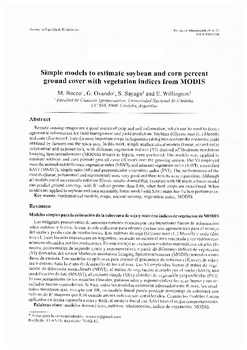| dc.contributor.author | Bocco, Mónica | |
| dc.contributor.author | Ovando, Gustavo Gabriel | |
| dc.contributor.author | Sayago, Silvina | |
| dc.contributor.author | Willington, Enrique | |
| dc.date.accessioned | 2022-05-02T16:43:22Z | |
| dc.date.available | 2022-05-02T16:43:22Z | |
| dc.date.issued | 2013 | |
| dc.identifier.citation | Bocco, M., Ovando, G. G., Sayago, S. y Willington, E. (2013). Simple models to estimate soybean and corn percent ground cover with vegetation indices from MODIS. Revista de Teledetección, 39, 83-91. http://www.aet.org.es/?q=revista39-8 | |
| dc.identifier.uri | http://hdl.handle.net/11086/24477 | |
| dc.identifier.uri | http://www.aet.org.es/?q=revista39-8 | |
| dc.description.abstract | Remote sensing images are a good source of crop and soil information, which can be used to derive agronomic information for field management and yield prediction. Soybean (Glycine max (L.) Merrill) and corn (Zea mays L.) are the most important crops in Argentina taking into account the economic yield obtained by farmers and the sown area. In this work, simple mathematical models (linear, second order polynomial and exponential), with different vegetation indices (VI) derived of Moderateresolution Imaging Spectroradiometer (MODIS) images as inputs, were evaluated. The models were applied to estimate soybean and corn percent ground cover (fCover) over the growing season. The VI employed were the normalized difference vegetation index (NDVI), soil adjusted vegetation index (SAVI), a modified SAVI (MSAVI), simple ratio (SR) and perpendicular vegetation index (PVI). The performances of the models (linear, polynomial and exponential) were very good and their results were equivalent. Although all models could successfully estimate fCover, results showed that, excepted with SR input, a linear model can predict ground coverage with R2 values greater than 0.86, when both crops are considered. When models are applied to soybean and corn separately, linear model with SAVI index has the best performance. | en |
| dc.description.abstract | Las imágenes provenientes de sensores remotos constituyen una importante fuente de información sobre cultivos y suelos, la cual puede utilizarse para obtener parámetros agronómicos para el manejo del suelo y predicción de rendimientos. Los cultivos de soja (Glycine max (L.) Merrill) y maíz (Zea mays L.) son los más importantes en Argentina, teniendo en cuenta el área sembrada y los réditos económicos obtenidos por los productores. En este trabajo se evaluaron modelos matemáticos simples (lineales, polinomiales de segundo grado y exponenciales), a partir de diferentes índices de vegetación (VI) derivados del sensor Moderate-resolution Imaging Spectroradiometer (MODIS) tomados como datos de entrada. Los modelos se aplicaron para evaluar el porcentaje de cobertura (fCover) de soja y maíz durante toda la etapa de desarrollo de los cultivos. Los VI empleados fueron el índice de vegetación de diferencia normalizada (NDVI), el índice de vegetación ajustado por el suelo (SAVI), una modificación de éste (MSAVI), el cociente simple (SR) y el índice de vegetación perpendicular (PVI). El comportamiento de los modelos (lineales, polinomiales y exponenciales) fue muy bueno y sus resultados fueron equivalentes. Si bien todos los modelos estimaron adecuadamente fCover, los resultados mostraron que, excepto con SR, un modelo lineal puede predecir porcentaje de cobertura con valores de R2 mayores que 0,86 cuando ambos cultivos son considerados. Cuando los modelos fueron aplicados en forma separada a soja y maíz, el modelo lineal con SAVI tuvo el mejor comportamiento | es |
| dc.language.iso | eng | es |
| dc.rights | Atribución-NoComercial-CompartirIgual 4.0 Internacional | * |
| dc.rights.uri | http://creativecommons.org/licenses/by-nc-sa/4.0/ | * |
| dc.source | Revista de Teledetección, 2013; 39, 83-91 | |
| dc.source | ISSN: 1988-8740 | |
| dc.source.uri | https://polipapers.upv.es/index.php/raet/index | |
| dc.subject | Modelos matemáticos | es |
| dc.subject | Cultivos | es |
| dc.subject | Teledetección | es |
| dc.subject | Sensores remotos | es |
| dc.subject | Índice de vegetación | es |
| dc.subject | MODIS | es |
| dc.title | Simple models to estimate soybean and corn percent ground cover with vegetation indices from MODIS | es |
| dc.type | article | es |
| dc.description.version | publishedVersion | es |
| dc.description.fil | Fil: Bocco, Mónica. Universidad Nacional de Córdoba. Facultad de Ciencias Agropecuarias; Argentina. | es |
| dc.description.fil | Fil: Ovando, Gustavo Gabriel. Universidad Nacional de Córdoba. Facultad de Ciencias Agropecuarias; Argentina. | es |
| dc.description.fil | Fil: Sayago, Silvina. Universidad Nacional de Córdoba. Facultad de Ciencias Agropecuarias; Argentina. | es |
| dc.description.fil | Fil: Willington, Enrique. Universidad Nacional de Córdoba. Facultad de Ciencias Agropecuarias; Argentina. | es |





